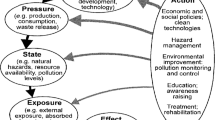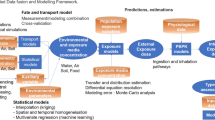Abstract
In response to the Walloon Environment and Health Program, the Scientific Institute of Public Services (ISSeP) developed an integrated approach of environmental exposure assessment in the Walloon region, Belgium. The study presents an index-based approach to estimate the multiple environmental burdens at regional level and detailed local resolution. Indicators are based on environmental measurements of pollutants in ambient air and soil, and on stressors for citizens related to noise and radon. These indicators were mapped as proportions to obtain an accurate comparison between spatial units. In order to indicate the need for intervention, environmental indicators are calculated as the proportion of areas where the level of detrimental environmental factors exceeds threshold values from WHO guidelines and Walloon legal threshold values. In parallel, a spatial web tool based on GIS was developed to enable a flexible and weighted combination of the normalized indicators by computing the resulting composite index online. This interactive web tool designed for policy makers and experts eases the spatial analysis of results in order to identify geographic areas where hotspot exposures are a potential risk to human health. The next steps of this work aim to integrate more environmental indicators (stressors and benefits) and some sociodemographic and health indicators in order to detect vulnerable populations. A holistic assessment is essential to inform environmental justice debates and to ensure a health conducive equal environment. Finally, this environmental health tool will support decision makers focus resources and programs to improve the environmental health of Walloons living in areas disproportionately burdened by multiple sources of pollution.





Similar content being viewed by others
References
Baysson H, Tirmarche M, Tymen G, Gouva S, Caillaud D, Artus JC, Vergnenegre A, Ducloy F, Laurier D (2004) Indoor radon and lung cancer in France. Epidemiology 15(6):709–716
Bolte G, Braubach M, Chaudhuri N et al (2012) Environmental health inequalities in Europe. Assessment report. World Health Organization, Copenhagen
Burgass MJ, Halpern BS, Nicholson E, Milner-Gulland EJ (2017) Navigating uncertainty in environmental composite indicators. Ecol Indic 75:268–278
Caudeville J, Boudet C, Govaert G et al (2011) Construction d’une plate-forme intégrée pour la cartographie de l’exposition des populations aux substances chimiques de l’environnement. Environ Risque Santé 10(3):239–242 (in French)
Caudeville J, Ioannidou D, Boulvert E, Bonnard R (2017) Cumulative risk assessment in the Lorraine region: a framework to characterize environmental health inequalities. Int J Environ Res Public Health 14(3):291
Cinelli G, Tondeur F, Dehandschutter B (2011) Development of an indoor radon risk map of the Walloon region of Belgium, integrating geological information. Environ Earth Sci 62(4):809–819
Corvalán C, Briggs D, Kjellstrom T (1996) Development of environmental health indicators. In: Briggs D, Corvalan C, Nurminen M (eds) Linkage methods for environment and health analysis: general guidelines. World Health Organization, pp 19–53
Curtis L, Rea W, Smith-Willis P, Fenyves E, Pan Y (2006) Adverse health effects of outdoor air pollutants. Environ Int 32(6):815–830
Cushing L, Faust J, August LM, Cendak R, Wieland W, Alexeeff G (2015) Racial/ethnic disparities in cumulative environmental health impacts in California: evidence from a statewide environmental justice screening tool (CalEnviroScreen 1.1). Am J Public Health 105(11):2341–2348
Faust J, August L, Bangia K et al (2017) CalEnviroScreen 3.0: Update to the California Communities Environmental Health Screening Tool. Office of Environmental Health Hazard Assessment, California Environmental Protection Agency, Sacramento
Flacke J, Schüle SA, Köckler H, Bolte G (2016) Mapping environmental inequalities relevant for health for informing urban planning interventions—a case study in the city of Dortmund, Germany. Int J Environ Res Public Health 13(7):711
Henschel S, Chan G (2013) Health risks of air pollution in Europe—HRAPIE project. World Health Organization, Copenhagen
Hsu A, Johnson LA, Lloyd A (2013) Measuring progress: a practical guide from the developers of the environmental performance index (EPI). Yale Center for Environmental Law & Policy, New Haven
Huang H, Wang A, Morello-Frosch R et al (2018) Cumulative risk and impact modeling on environmental chemical and social stressors. Curr Environ Health Rep 5(1):88–99
Institut wallon de l’évaluation de la prospective et de la statistique IWEPS (2018a) Densité de population en Wallonie. https://www.iweps.be/indicateur-statistique/densite-de-population/. Accessed 14 Sept 2018
Institut wallon de l’évaluation de la prospective et de la statistique IWEPS (2018b) Régions urbaines en Wallonie. https://www.iweps.be/indicateur-statistique/regions-urbaines/. Accessed 14 Sept 2018
Institut wallon de l’évaluation de la prospective et de la statistique IWEPS (2018c) Utilisation du sol en Wallonie. https://www.iweps.be/indicateur-statistique/utilisation-du-sol/. Accessed 14 Sept 2018
Institut wallon de l’évaluation de la prospective et de la statistique IWEPS (2018d) Densité des infrastructures de transport en Wallonie. https://www.iweps.be/indicateur-statistique/densite-infrastructures-de-transport/. Accessed 14 Sept 2018
Institut wallon de l’évaluation de la prospective et de la statistique IWEPS (2018e) Transport aérien en Wallonie. https://www.iweps.be/indicateur-statistique/transport-aerien/. Accessed 14 Sept 2018
International Agency for Research on Cancer, World Health Organization (2013) IARC: Outdoor air pollution a leading environmental cause of cancer deaths. Press release No. 221. World Health Organization
Longley PA, Goodchild MF, Maguire DJ, Rhind DW (2005) Geographic information systems and science. Wiley, Hoboken
Medina S, Le Tertre A, Saklad M, Apheis Collaborative Network (2009) The APHEIS project: air pollution and health – a European information system. Air Qual Atmos Health 2(4):185–198
Morello-Frosch R, Zuk M, Jerrett M, Shamasunder B, Kyle AD (2011) Understanding the cumulative impacts of inequalities in environmental health: implications for policy. Health Aff 30(5):879–887
Nardo M, Saisana M, Saltelli A, Tarantola S (2005) Tools for Composite Indicators Building. EUR 21682 EN. Econometrics and Statistical Support to Antifraud Unit. Institute for the Protection and Security of the Citizen, Joint Research Centre (JRC), Ispra
Occelli F (2014) Systèmes d’Information Géographique et Lien Environnement–Santé (SIGLES): contribution au développement d'outils cartographiques d'aide à la décision face aux risques sanitaires liés à l'environnement. Doctoral dissertation, Université du Droit et de la Santé-Lille II (in French)
Office of Environmental Health Hazard Assessment, OEHHA (2018) CalEnviroScreen. https://oehha.ca.gov/calenviroscreen. Accessed 14 Sep 2018
Pärt P, Jarosinska D, Hoogeveen Y (2013) Environment and human health—Joint EEA-JRC report no. 5. European Environment Agency
Pascal M, Medina S (2012) Résumé des résultats du projet Aphekom 2008-2011. Des clefs pour mieux comprendre les impacts de la pollution atmosphérique urbaine sur la santé en Europe. Institut de veille sanitaire (InVS), Saint-Maurice 6 p (in French)
Pereira B, Sonnet P (2007) La contamination diffuse des sols par les éléments traces métalliques en Région wallonne. Dossier scientifique réalisé dans le cadre de l’élaboration du Rapport analytique 2006–2007 sur l’état de l’environnement wallon, 27p (in French)
Saib MS, Caudeville J, Beauchamp M, Carré F, Ganry O, Trugeon A, Cicolella A (2015) Building spatial composite indicators to analyze environmental health inequalities on a regional scale. Environ Health 14(1):68
Science Communication Unit (2013) Science for environment policy in-depth report: soil contamination: impacts on human health. Report produced for the European Commission DG Environment. University of the West of England, Bristol
Selander J, Nilsson ME, Bluhm G, Rosenlund M, Lindqvist M, Nise G, Pershagen G (2009) Long-term exposure to road traffic noise and myocardial infarction. Epidemiology 20:272–279
Sexton K (2012) Cumulative risk assessment: an overview of methodological approaches for evaluating combined health effects from exposure to multiple environmental stressors. Int J Environ Res Public Health 9(2):370–390
Shrestha R, Flacke J, Martinez J, Van Maarseveen M (2016) Environmental health related socio-spatial inequalities: identifying “hotspots” of environmental burdens and social vulnerability. Int J Environ Res Public Health 13(7):691
Shrestha R, Köckler H, Flacke J, Martinez J, Van Maarseveen M (2017) Interactive knowledge co-production and integration for healthy urban development. Sustainability 9(11):1945
Shrestha R, Flacke J, Martinez J, van Maarseveen M (2018) Interactive cumulative burden assessment: engaging stakeholders in an adaptive, Participatory and Transdisciplinary Approach. Int J Environ Res Public Health 15(2):260
Stephenne N, Remy S, Eloy S, Stassen F, Defoux J (2013) A Walloon spatial simulation model of risks in environment and health. Environmental Health Risk VII, 16, 35
Straif K, Cohen A, Samet J, International Agency for Research on Cancer (2013) IARC Scientific Publication No. 161: Air Pollution and Cancer. World Health Organization, Geneva
Sugumaran R, Degroote J (2010) Spatial decision support systems: principles and practices. CRC Press, Boca Raton
Tondeur F, Cinelli G, Dehandschutter B (2014) Homogenity of geological units with respect to the radon risk in the Walloon region of Belgium. J Environ Radioact 136:140–151
Walloon Public Service SPW - DGO3 (2010) Tableau de bord de l’environnement wallon. Delbeuck C (Ed.), Etat de l’environnement wallon (in French)
Walloon Public Service SPW – DGO3 (2015) Code Wallon de Bonnes Pratiques – version 2 – Guide de référence pour l’étude de risques – partie B : Evaluation des risques pour la santé humaine (in French)
World Health Organization WHO (2009a) WHO handbook on indoor radon: a Public Health perspective. Angell WJ, Zeeb H, Shannon F
World Health Organization WHO (2009b) In: Hurtley C (ed) Night noise guidelines for Europe. WHO Regional Office Europe, København
World Health Organization WHO (2011) Burden of disease from environmental noise: Quantification of healthy life years lost in Europe. In Burden of disease from environmental noise: Quantification of healthy life years lost in Europe, pp 126–126
World Health Organization WHO (2013) Review of evidence on health aspects of air pollution–REVIHAAP Project
World Health Organization WHO (2017) Risk factors. In: WHO. http://www.who.int/topics/risk_factors/en/. Accessed 14 Sept 2018
World Health Organization WHO and UNAIDS (2006) Air quality guidelines: global update 2005
Acknowledgments
Authors wish to thank members of the steering committee of the SIGEnSa project for their feedback and guidance on methodology, indicator and data selection, and preliminary results. Authors also thank the Walloon Public Service (SPW), the Scientific Institute of Public Services (ISSeP), the Université Catholique de Louvain (UCLouvain), and the Federal Agency for Nuclear Control (AFCN) for providing the data.
Funding
This work is part of the SIGEnSa project financially supported by the ministerial funds for the Risk Assessment (decree D-31-3800), committed by the Cellule Permanente Environnement Santé (CPES) of the Walloon Public Service (SPW).
Author information
Authors and Affiliations
Corresponding author
Ethics declarations
Conflict of interest
The authors declare that they have no conflict of interest.
Additional information
Responsible editor: Philippe Garrigues
Publisher’s note
Springer Nature remains neutral with regard to jurisdictional claims in published maps and institutional affiliations.
Rights and permissions
About this article
Cite this article
Habran, S., Crespin, P., Veschkens, M. et al. Development of a spatial web tool to identify hotspots of environmental burdens in Wallonia (Belgium). Environ Sci Pollut Res 27, 5681–5692 (2020). https://doi.org/10.1007/s11356-019-04418-5
Received:
Accepted:
Published:
Issue Date:
DOI: https://doi.org/10.1007/s11356-019-04418-5




